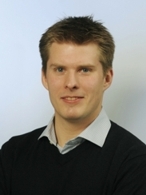
Abstract
The current focus of material development in the field of organic bulk heterojunction solar cells is on donor-acceptor type low-bandgap materials, since their extended red to near-infrared absorption allows them to harvest a larger fraction of the solar illumination, allowing larger photocurrents to be potentially obtained. In my talk I will present our recent results on exciton diffusion, charge transfer, charge separation and recombination in blends of low-bandgap polymers or small donor molecules with fullerene or non-fullerene acceptors studied by broadband Vis-NIR transient absorption spectroscopy spanning a dynamic range from femto- to milliseconds. More specifically, I will demonstrate that upon excitation of the acceptor, exciton diffusion-limited charge separation can be observed, which extends up to several hundred picoseconds in the case of fullerene derivatives, while excitation of the polymer mostly leads to ultrafast charge separation at the interface. Furthermore, I will show that in several low-bandgap polymer:fullerene blends an additional loss channel exists, namely triplet formation by non-geminate recombination of free charges, as has also recently been demonstrated by the Friend group for PCPDTBT:PCBM blends.[1] As an example, I will show our recent spectroscopic results on PSBTBT,[2] the silicon-bridged derivative of PCPDTBT,[3] and furthermore, how soft-modeling of TA data surfaces using multivariate curve resolution (MCR) analysis, can be used to deconvolve the individual spectral components of singlet excitons, free charges and triplet states, including their respective dynamics.[4] Our measurements and data analyses allow us to track the entire cascade of photophysical processes from exciton diffusion and dissociation to free charge formation, and finally to non-geminate recombination and triplet formation in low-bandgap polymer:fullerene blends and related photovoltaic material systems using non-fullerene acceptors such as perylene diimide derivatives for instance.[5]
References:
[1] A. Rao et al., Nature 2013, 500 (7463), 435. [2] F. Etzold, I.A. Howard, F. Laquai, in preparation. [3] F. Etzold, I.A. Howard, N. Forler, D.M. Cho, M. Meister, H. Mangold, J. Shu, M.R. Hansen, K. Müllen, F. Laquai, J. Am. Chem. Soc. 2012, 134 (25), 10569-10583. [4] I.A. Howard, H. Mangold, F. Etzold, D. Gehrig, F. Laquai, Transient Absorption Data Analysis by Soft-Modeling. In: G. Gurzadyan, G. Lanzani, C. Soci, T.C. Sum (Ed.): Ultrafast Dynamics in Molecules, Nanostructures and Interfaces, World Scientific - Series in Optics and Photonics - Vol. 8 2014, S. 53- 78. [5] D. Gehrig, I. A. Howard, V. Kamm, C. Dyer-Smith, F. Etzold and F. Laquai, Proc. SPIE 8811, Physical Chemistry of Interfaces and Nanomaterials XII 2013, 88111F, DOI: 10.1117/12.2023757.
Biography
Dr. Frederic Laquai received his diploma in Chemistry in 2003 from the universities of Oldenburg, Marburg and Cambridge and his PhD from the Max Planck Institute for Polymer Research in 2006. From 2006-2008, he was a postdoctoral fellow at the University of Cambridge in the Cavendish Laboratory under the supervision of Professor Sir Richard Friend. Since 2008, Dr. Frederic Laquai has been the head of the Max Planck Research Group for Organic Optoelectronics at the Max Planck Institute for Polymer Research. His research focuses on improved understanding of the photophysical processes in organic electronic devices using ultrafast spectroscopy in conjunction with other techniques.